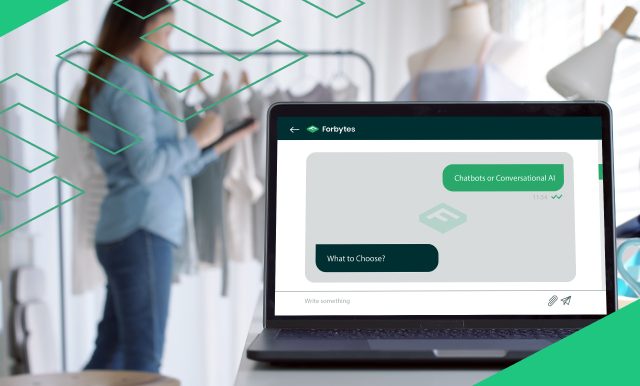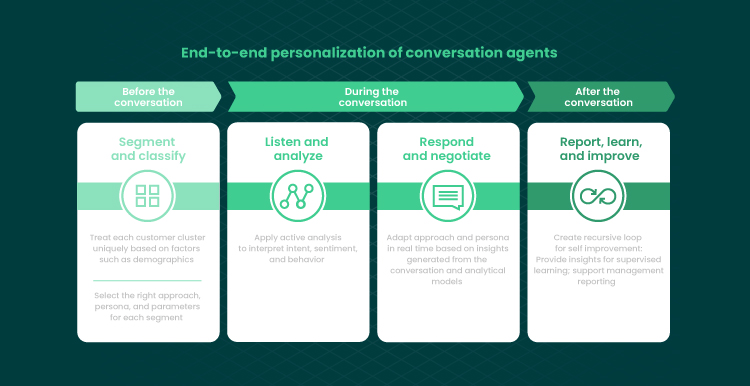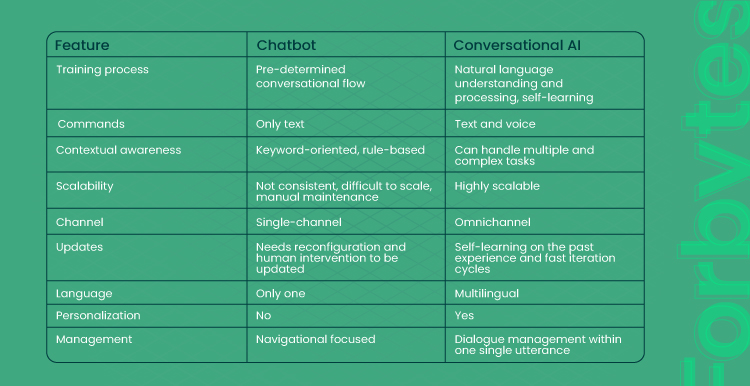Chatbots and conversational AI are terms used interchangeably. Although businesses tend to interpret them similarly, they do not mean the same. Chatbots differ greatly from conversational AI, especially when it comes to specific business use cases. Nevertheless, their common goal is to enhance customer experience and ensure better engagement.
Let us shed light on the two notions that definitely are a part of the retail future. But first, we would like to relate some historical facts about how a chatbot was born.
The History of Chatbots
The first chatbot was born in 1966 before the launch of personal computers. That year, Joseph Weizenbaum, the MIT computer scientist, introduced a “chatbot” called Eliza. It operated on a limited pre-determined flow. The chatbot utilized pattern matching and substitution technology and was simulating a doctor. Yet, Eliza couldn’t contextualize events since there was no in-built framework.
The next progressive advent was a chatbot PARRY, designed eight years later by Kenneth Mark Colby at Stanford’s Laboratory. It behaved opposite to Eliza and was simulating paranoid schizophrenic thinking. In contrast to Eliza, PARRY passed a full Turing test, which determined its more advanced structure.
In 1995, ALICE (Artificial Linguistic Internet Computer Entity) appeared. This chatbot was a step forward in the history of chatbots. It was written with Artificial Intelligence Markup Language, which consisted of 41,000 templates and patterns, and was acknowledged as the best human-like computer program. ALICE even won the title of the Loebner Prize. However, the chatbot was not sophisticated enough to impact the real revolution in chatbot technology. Instead, it was SmarterChild that made a difference on the market. The chatbot was designed in 2001 and aimed at aiding millions of American Online Instant Messenger (AIM) users with practical daily tasks.
Quite later, the creation of intelligent voice assistants built into smart devices facilitated the rise of such advanced solutions as Apple Siri, Watson Assistant, Microsoft Cortana, Amazon Alexa, and Google Assistant
So What Is a Chatbot?
Chatbots fulfill the function of automated customer interaction with the help of pre-defined conversational flow, rule-based commands, and keywords. The conversation between a chatbot and a human looks as follows: a user picks an option, the rule-based flow starts working, and the conversation keeps going. That is, a user gets an answer to the question that is input in advance, which leads to the following query.
A chatbot aims to help customers with elementary queries and helps them answer frequently asked questions. But it does not mean that they are not capable of generating qualified leads or planning an online meeting via an integrated calendar. All these options can be achieved with chatbots. However, they are not powered by artificial intelligence that can learn from previous experience. Instead, chatbots follow its pre-determined navigated path leading to the next pre-determined questions.
What Is a Conversational AI?
Conversational AI is an advanced technology backed by natural language processing (NLP) and Machine learning (ML) algorithms. They can learn from past events and offer superior performance to the customers. Unlike chatbots, they can intelligently interpret what customers want and provide a level-up response.
The standard architecture of conversational AI encompasses such technologies as:
- Automatic speech recognition (ASR)
- Natural language understanding (NLU)
- Natural language generation (NLG)
- Dialogue Manager (DM)
- Machine learning models (ML) and Deep neural networks (DNN).
With these technologies, a scheme for implementing conversational AI looks like that one. ASR (automatic recognition of human speech) takes the information input from the user in the form of text or audio and deciphers it into a machine-readable format. Then, it transmits the input further to NLU (natural language understanding) to comprehend the core semantics of the text.
Hereafter, the application uses DM (dialogue management) to identify the dialogue domain, comprehend sentences, and formulate the responses correspondingly. It converts them into a human-understandable format via NLG (natural language generation).
To provide an appropriate response, the application uses reinforced learning, one more technology that facilitates learning from past experience over time to deliver more solid answers to the users.
The COVID-19 Crisis and the Acceleration of AI Conversational
The global conversational AI market size is predicted to increase from $6,8 billion in 2021 to $18,4 billion by 2026. And it’s not surprising: accelerated by COVID-19, businesses have stepped on the path of AI conversational marketing to satisfy the changing demands of customers. The latter are now looking for enhanced experiences with quick and smart aid to their queries. Ankit Chhajer, the AI Lead at NatWest, called Conversational AI a “superhero” during the COVID pandemic. In effect, a leading UK bank quickly adapted to the shifting demands of customers and applied CORA, their virtual assistant, to ensure personalized answers to customers in a matter of minutes.
Conversational AI vs. Chatbots: Features Comparison
While chatbots are the predecessors of Conversational AI models, the latter are more powerful as they provide businesses with solutions containing machine learning technologies. They allow for the creation of more accurate responses.
Let’s outline the features of chatbots first:
- Keyword-focused
- Rule-based
- Have pre-defined answers
- Cannot learn over time
- Guided navigation
- Need reconfiguration for any updates
- Human maintenance
- Time-consuming to scale
- Only text-based
Features of a conversational AI tool:
- User-friendly
- Multi-language compatibility
- Dialogue-focused
- Dynamic interactions
- Voice and text commands
- Highly scalable
- Omnichannel
- Usage of deep learning models
- Self-learning
To better compare each feature of both solutions, we propose to classify them by the following criteria:
Training process
According to Deloitte’s survey, the conventional rule-based chatbot approach needs more training time: from 6 to 9 months. Moreover, pre-determined conversational flows may cause inadequate and unsatisfying understanding.
With conversational AI, the training process is accelerated by unsupervised NLU, allowing applications to better comprehend inputs from users and generate much more qualitative responses. Having learned from previous customer interactions, an AI-driven chatbot is empowered with the capability to deliver multi-iterated responses. What’s more, a conversational AI chatbot can detect and mitigate preconceptions in training data. It may help you prevent misleading that is, for example, related to unsatisfied customers when what is said is not true.
Ability to Handle Complex Customer Conversations
Conventional chatbots cannot understand multiple intents as compared to conversational AI capable of involving numerous commands in a single conversation. Therefore, simple chatbots only manage to resolve simple requests. If a customer asks questions containing two different aspects, a chatbot will answer the first one and ignore the second part of the query. Afterward, to resolve another part of the query, a customer has to repeat it separately so that a chatbot is able to understand it. And that, in turn, can lead to frustrated customers who feel upset due to automated responses.
But these days, the reality has changed a lot, and AI-powered chatbots enable enterprises to carry out a sheer number of tasks across departments. AI-powered chatbots are based on conversational AI work that can switch between topics and provide customers with sophisticated and accurate responses throughout a single conversation. Moreover, with AI, an application can fulfill several intents, such as reserving a table in a restaurant and scheduling it in the calendar, for example.
Scalability & Consistency
Unlike chatbots being unconnected and scattered across different platforms, conversational AI is powered by different sources and functions as a consistent conversational flow. That means that conversational artificial intelligence can handle fluid interactions with users without the need to produce the output by manually inserting it into the flow. Therefore, with conversational AI, virtual assistants or digital voice assistants throughout the enterprise can be integrated and speak the same. For instance, if users start their conversation via one service and want to switch to another, the conversational AI will automatically complete the task.
Providing an omnichannel presence at scale, conversational AI can be presented in various forms like voice assistants (Siri, Google Home), smart speakers (Amazon Alexa), or even virtual call centers agents (Zendesk Talk). A virtual assistant can even offer an alternative service provider in case it fails to help the customer. Such orchestration makes it easier to maintain and scale up conversational AI.
Hence, conversational AI will be your win-win solution if you have a set of digital channels and would like to cross over mediums.
Personalization
According to the Deloitte survey, personalization can be a significant determinant of positive customer experience and business outcomes. Based on customers’ attributes, conversational agents adapt to customers’ preferences and change speed if necessary. If a conversational AI identifies that a customer is unsatisfied, it may even involve a sales manager to help resolve the inquiry. In the case of chatbots, it is not possible to personalize the conversation.
Here is what end-to-end personalization of conversational AI tools looks like:
In addition, it is worth mentioning of multilingualism of conversational AI solutions in contrast to script-based chatbots that cannot carry out commands in different languages.
The Business Value of AI-Powered Chatbots
According to data from various conversational AI vendors, the number of conversations conducted by conversational AI has grown by as much as 250% in a variety of industries. At the same time, the global chatbot market is constantly evolving and is predicted to reach $452,8 million in revenue, up from $65.5 million in 2020. Nowadays, businesses are in dire need to implement customizable AI-powered chatbots. With changing demands of customers, the approaches to issue resolution require progressive and smart solutions.
Comparing chatbot vs. conversational AI in the context of business value in today’s market, companies need to realize the powerful impact of AI. Yes, there still are standard pre-defined chatbots, but by leveraging machine learning and natural language processing NLP, businesses get more prodigious opportunities to gain a competitive edge.
When carried out as a comprehensive and customizable solution, an AI-powered chatbot can help yield key benefits in the following applications:
- Customer service. As mentioned above, chatbots can engage customers via personalized conversations without the need to distract a customer service agent. In addition, they can communicate with customers to resolve their queries, accept complaints or requests, and collect their feedback. Let’s take inventory management as an example. When a customer wants to check the delivery time of their package, a chatbot helps them figure out this query, diminishing users’ need to distract from their strategic tasks.
- Human resources. Chatbots can be useful in a range of HR activities. For example, they help employees register their time offs and vacations, navigate through internal documentation, and answer common HR-related questions. Moreover, AI-backed chatbots allow recruiters to be more focused on interviews by sending messages to candidates and answering their questions while providing recruiters with candidates’ metrics.
- Marketing. Chatbots are a great automation tool to streamline marketing efforts and enhance eCommerce business performance. They can ask questions tailored to your online customers, offer them personalized recommendations, and foster email collection with the help of customizable conversations on the website.
- Sales. This application covers extensive vistas for eCommerce sales efforts, especially in the retail niche. With chatbots deployed in social media accounts and on websites, your customers can place orders within a second. They can get personalized recommendations based on previous purchases. Furthermore, lead generation chatbots can help grease the wheels of website visitors by segmenting them based on their responses. With sales questionnaires, a chatbot can appoint the right sales rep to follow up. If your queries are focused mostly on appointment or hotel bookings, chatbots can help visitors self-schedule events, send invitations, and inform about future meetings.
AI chatbots can be implemented in the out-of-the-box scenario if a business type requests one. Ranging from simple FAQ-related requests to more advanced queries, chatbots can be deployed in the following industries:
- Real estate. In 2022, millennials and Gen Z will dominate the market. As their example shows, today’s customer is looking for solutions where humans are less involved. In the real estate environment, AI chatbots will be a worthwhile endeavor (if not implemented yet) for companies striving to indulge their customers and close more deals. Conversational AI chatbots can be your win-win solution for arranging appointments for pre-built houses, following up on your leads, or promoting cross-selling opportunities for long-term clients. For example, Apartment Ocean, an AI-powered virtual customer representative, helps real estate companies bolster customer satisfaction by reducing acquisition expenses.
- Healthcare. In this industry, both doctors and patients can find chatbots beneficial. Chatbots can be programmed to handle insurance coverage inquiries, answer questions regarding medical procedures, illnesses, drug interactions, etc. Medical assistants can have chatbots at work when they need to collect patient details, for example. One of the most widespread applications of healthcare chatbots is depression treatment. Woebot, a personal mental health assistant, helps patients with mental disorders. Via brief daily conversations, an AI chatbot provides suggestions of various clinical tools and tactics for patients.
- Finance. The banking industry is one where qualitative online support is of high importance. Via chatbots, customers can perform such queries as creating deposits, getting advice on investment issues, buying stocks, reporting stolen cards, or redirecting to specialists who can handle more complex issues. In addition, banking institutions can apply virtual assistants to analyze contracts, engage employees, facilitate the management of internal processes, etc. Among the real-life examples are the Australian Ceba and Erica, the virtual assistant from Bank of America.
- Hospitality. Being a personal travel assistant or virtual concierge, a chatbot can provide customers and companies with real-time data. Chatbots can enable them to self-schedule rooms, book cabs, deliver insights on local bars and restaurants, etc. Additional services can be promoted via cross-selling strategies with the implementation of artificial intelligence assistants that can self-learn from previous experiences. Moreover, chatbots are designed on natural language processing standards, so there are no constraints regarding the language barrier.
Wrap Up
With the growing adoption of artificial intelligence, machine learning, and natural learning processing, conversational AI is gaining much popularity. This form of digital voice assistants, virtual assistants, and virtual call canter agents is predicted to skyrocket. The global chatbot market is on the same wavelength: 67% of customers used a chatbot for customer service conversations. Derived from chatbots, conversational AI applications are an advanced solution for businesses whose aim is to resolve complex tasks and deliver sophisticated resolutions to their multiple customers.
Contact us to consult with our experts who can help you implement a customizable solution tailored to your needs and your specific use case.

Our Engineers
Can Help
Are you ready to discover all benefits of running a business in the digital era?

Our Engineers
Can Help
Are you ready to discover all benefits of running a business in the digital era?










